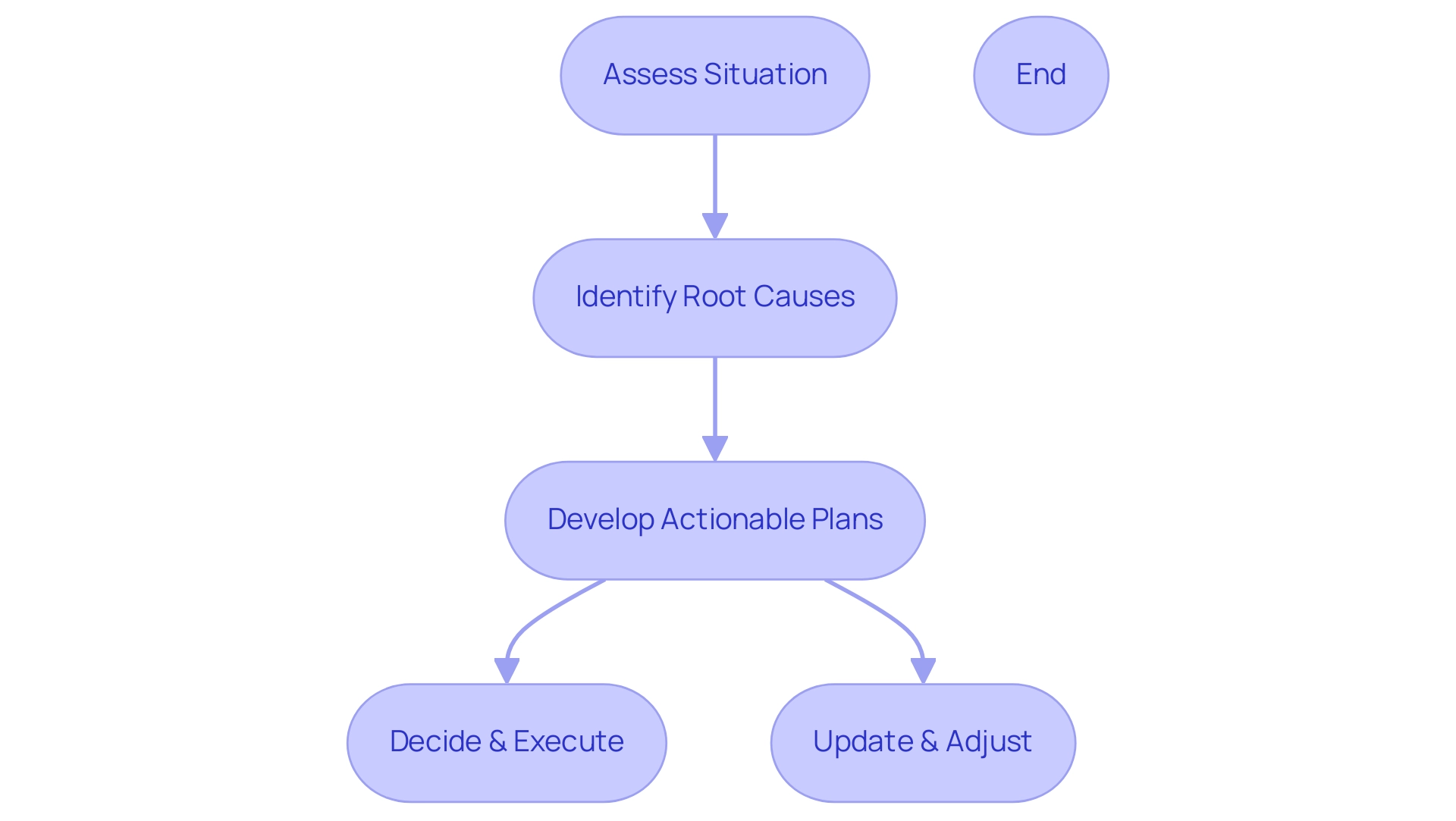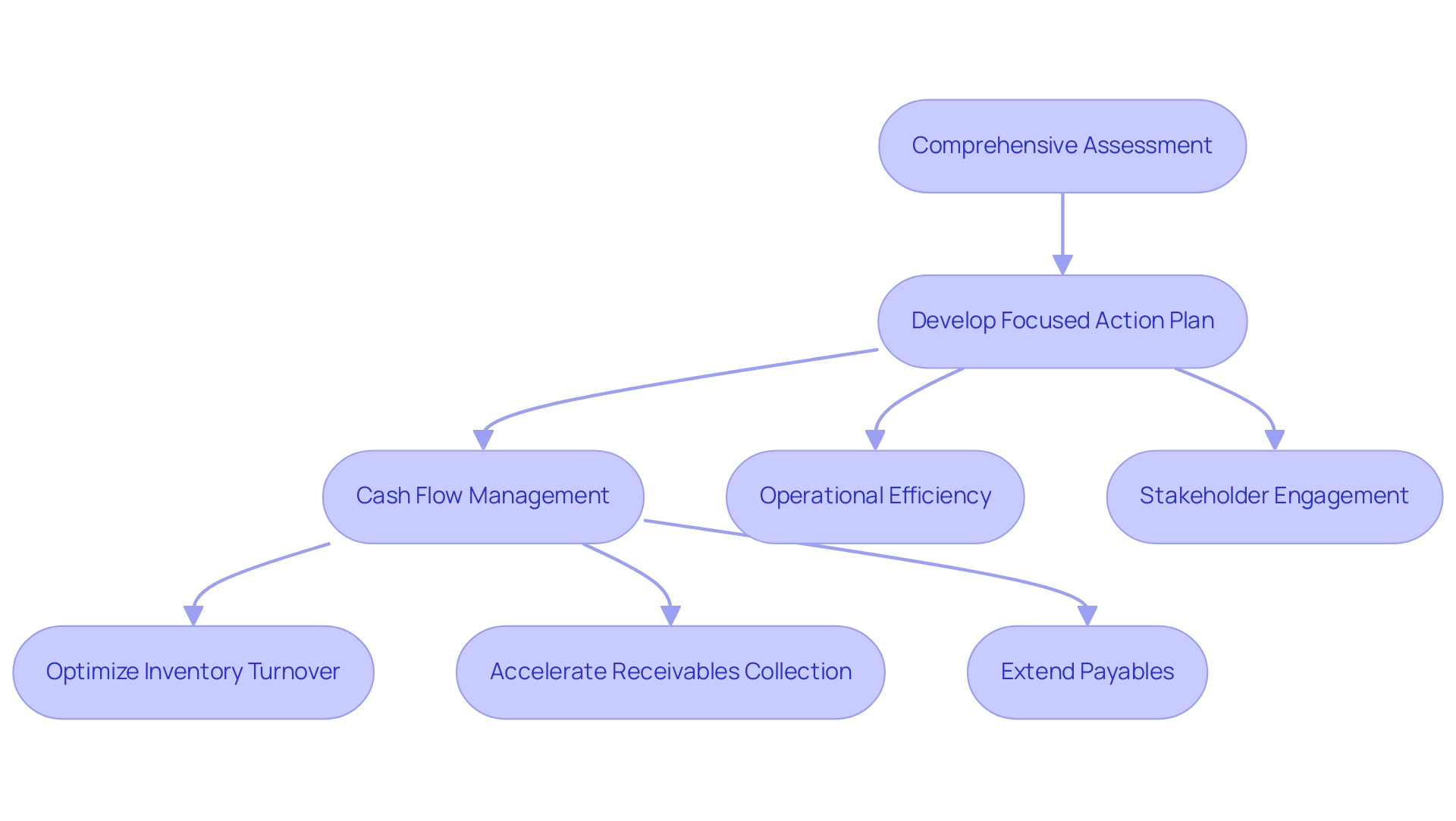Introduction
In the ever-evolving landscape of business, organizations often find themselves at critical junctures that demand immediate and effective leadership. Interim management emerges as a vital solution for distressed companies navigating through turbulent waters, offering experienced professionals who can step in and drive necessary changes during times of crisis.
By harnessing real-time analytics and strategic decision-making, interim managers not only bridge leadership gaps but also implement turnaround strategies that can lead to significant operational improvements.
This article delves into the essential roles and skills of interim managers, showcasing how their expertise can restore stability and confidence in organizations facing adversity. Through compelling case studies and actionable insights, it becomes clear that interim management is not just a stopgap measure; it is a powerful catalyst for transformation and sustainable growth.
Defining Interim Management: A Key Solution for Distressed Businesses
Interim management is defined as the strategic deployment of experienced management resources temporarily during periods of transition or crisis. This approach is essential for interim management for distressed businesses grappling with operational challenges, financial instability, or substantial change. By utilizing real-time analytics via a client dashboard and efficient decision-making processes, temporary leaders can significantly improve turnaround effectiveness.
For instance, a case study involving an interim Chief Restructuring Officer (CRO) illustrates this, resulting in a 20% increase in operational efficiency and a 15% reduction in operational costs. Interim management for distressed businesses involves leaders who are adept at filling critical leadership gaps, implementing essential changes, and establishing stability within the organization while a permanent solution is pursued. Their specialized expertise not only enables organizations to sustain operational continuity but also facilitates a focused recovery process, allowing teams to test hypotheses and quickly adapt strategies as needed.
This proactive approach mitigates risks associated with prolonged vacancies in leadership and signals to stakeholders that the organization is actively addressing pressing issues. Additionally, appointing an interim leader can restore investor confidence during tumultuous times, underscored by the fact that hiring an interim CRO for 8 months can save organizations approximately $150,000 compared to recruiting a full-time CRO. The lessons learned during this process are operationalized to ensure continuous improvement and effectiveness in decision-making.
Essential Skills and Expertise of Interim Managers in Crisis Situations
Interim management for distressed businesses provides a diverse skill set that is crucial for navigating crises and enhancing organizational performance. With competencies in strong financial management and strategic planning, they excel in streamlined decision-making and utilize real-time analytics to monitor business health. Their ability to quickly assess situations, identify root causes of distress, and develop actionable plans enables them to implement effective interim management for distressed businesses.
A key aspect of their approach includes mastering the cash conversion cycle, which helps optimize cash flow and operational efficiency. Furthermore, they employ structured processes like:
- 'Decide & Execute' to facilitate rapid decision-making
- 'Update & Adjust' to continuously refine strategies based on real-time data
Their extensive experience across various industries equips them with insights into best practices and innovative solutions tailored to specific organizational challenges.
This expertise not only drives sustainable growth but also fosters strong relationships through the operationalization of lessons learned during the interim management for distressed businesses turnaround process.

The Vital Role of Interim Management in Business Restructuring
Interim management for distressed businesses plays a critical role in restructuring, offering experienced leadership during transformative periods. These supervisors are not only tasked with executing restructuring plans—which may involve downsizing, streamlining operations, or shifting strategic direction—but they also leverage a pragmatic approach to data. By testing hypotheses and employing real-time analytics through tools like our client dashboard, they can make informed, swift decisions that minimize disruption and maintain stakeholder confidence.
Their ability to operationalize lessons learned through continuous monitoring fosters the development of strong, lasting relationships across departments, ensuring alignment with organizational goals, which is crucial for the success of any turnaround effort. This commitment to effective communication and decisive action is essential for interim management for distressed businesses, enabling organizations to navigate challenges and emerge stronger.
Strategic Approaches of Interim Managers in Crisis Management
Interim management for distressed businesses involves leaders employing various strategic approaches to effectively handle crises, beginning with a comprehensive assessment of the organization's current state to identify immediate risks and opportunities for improvement. This foundational analysis informs the development of a focused action plan that emphasizes interim management for distressed businesses, prioritizing critical areas such as:
- Cash flow management
- Operational efficiency
- Stakeholder engagement
Specific approaches for mastering the cash conversion cycle include:
- Optimizing inventory turnover
- Accelerating receivables collection
- Extending payables without jeopardizing supplier relationships
By utilizing real-time analytics through a client dashboard, temporary managers ensure continuous monitoring of performance, allowing for timely adjustments based on data insights. They also leverage their networks to bring in additional expertise or resources as needed, ensuring that the organization has the support required to navigate challenges. Their adaptability and quick decision-making, supported by ongoing performance tracking and the operationalization of turnaround lessons, are key assets in executing these plans successfully.

Case Studies: Successful Interim Management in Action
Multiple case studies demonstrate the effect of interim management for distressed businesses in struggling companies, highlighting the transformative approaches utilized by the SMB team. For example, a retail chain encountering significant financial troubles utilized interim management for distressed businesses by hiring a temporary leader who executed a turnaround plan focused on testing hypotheses and operational efficiency. Within six months, the company saw a remarkable 30% reduction in operating costs and successfully returned to profitability.
Similarly, a restaurant group experiencing declining sales benefited from interim management for distressed businesses, as an interim manager revitalized its marketing strategy and streamlined operations. This led to a 25% increase in revenue within the first quarter of their engagement. These examples underscore the power of real-time analytics and quick decision-making in driving recovery and growth.
Through our client dashboard, organizations can monitor their health in real time, enabling them to make informed decisions quickly. The 'Decide & Execute' process allows teams to take decisive actions based on these insights, while the 'Update & Adjust' process ensures continuous improvement and adaptation. Effective interim management for distressed businesses can transform organizations, allowing them to focus on serving their customers.
Conclusion
The role of interim management in navigating business crises is not just a temporary fix; it is a strategic necessity that enables organizations to regain stability and foster growth. Interim managers bring a wealth of experience and specialized skills that are crucial for addressing operational challenges and implementing effective turnaround strategies. Their ability to leverage real-time analytics and make informed decisions allows companies to optimize performance, streamline operations, and restore stakeholder confidence.
Through the examination of various case studies, it is evident that interim management can lead to significant operational improvements, as demonstrated by remarkable reductions in costs and increases in revenue. These success stories highlight the importance of a proactive approach, where interim managers utilize structured processes to adapt and refine strategies in real time, ensuring that organizations remain agile in the face of adversity.
In conclusion, investing in interim management is an actionable strategy that not only addresses immediate leadership gaps but also positions businesses for long-term success. By embracing this approach, organizations can effectively navigate crises, capitalize on opportunities for improvement, and emerge stronger and more resilient. Now is the time for companies to recognize the transformative potential of interim management as a catalyst for sustainable growth and operational excellence.
Frequently Asked Questions
What is interim management?
Interim management is the strategic deployment of experienced management resources temporarily during periods of transition or crisis, particularly essential for distressed businesses facing operational challenges, financial instability, or significant changes.
How does interim management benefit distressed businesses?
Interim management provides leaders who can fill critical gaps, implement necessary changes, and establish stability while a permanent solution is sought. This approach helps sustain operational continuity and facilitates a focused recovery process.
Can you give an example of the effectiveness of interim management?
A case study involving an interim Chief Restructuring Officer (CRO) showed a 20% increase in operational efficiency and a 15% reduction in operational costs, demonstrating the significant impact of interim management.
What specific skills do interim managers possess?
Interim managers have a diverse skill set, including strong financial management, strategic planning, and the ability to utilize real-time analytics for decision-making. They excel in assessing situations quickly and developing actionable plans.
What processes do interim managers use to enhance decision-making?
Interim managers employ structured processes such as 'Decide & Execute' for rapid decision-making and 'Update & Adjust' for continuous strategy refinement based on real-time data.
How do interim managers optimize cash flow?
They master the cash conversion cycle by optimizing inventory turnover, accelerating receivables collection, and extending payables without jeopardizing supplier relationships.
What role does data play in interim management?
Data is crucial for interim management, enabling leaders to monitor business health through real-time analytics, make informed decisions, and adjust strategies promptly to minimize disruptions.
How can appointing an interim leader affect investor confidence?
Appointing an interim leader can restore investor confidence during challenging times, as it signals that the organization is actively addressing pressing issues.
What are some outcomes of successful interim management?
Successful interim management can lead to significant improvements, such as reduced operating costs and increased revenue, as demonstrated by various case studies involving organizations that implemented effective turnaround strategies.
How does interim management ensure continuous improvement?
Interim management operationalizes lessons learned during the turnaround process, fostering sustainable growth and strong relationships through effective communication and ongoing performance monitoring.




